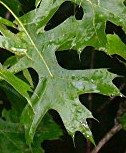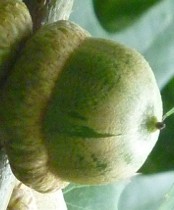 Pin oak, also known as swamp Spanish oak, is a deciduous tree native of Eastern and Central US where it grows in areas with moist acid soils such as floodplains, river bottoms, and along streams. It is a member of the oak family, Fagaceae, that also includes beeches and chestnuts. The trees grow in a pyramidal shape with the highest branches upright, the mid-level branches horizontal, and the lower branches drooping downward. The trunk is straight and has smooth, light to dark grayish brown bark with shallow, scaly ridges. The simple alternate leaves are four to six inches long by two to four inches wide and are deeply cut into five or seven bristle tipped lobes. They are glossy dark green in the summer turning to red in the fall. Insignificant greenish yellow male and female flowers appear in catkins on the same tree in spring as the leaves emerge. Acorns ½ inch long with shaped cups that enclose one third of the nut appear in fall and mature in the second year. Pin oaks are very popular street and landscape trees due to their handsome appearance, ease of transplanting, relatively rapid growth, and pollution tolerance. The genus name, Quercus, is the Latin name for oak tree. The specific epithet, palustris, comes from the Latin word palus, meaning marsh, and refers to the natural habitat of the tree.
Pin oak, also known as swamp Spanish oak, is a deciduous tree native of Eastern and Central US where it grows in areas with moist acid soils such as floodplains, river bottoms, and along streams. It is a member of the oak family, Fagaceae, that also includes beeches and chestnuts. The trees grow in a pyramidal shape with the highest branches upright, the mid-level branches horizontal, and the lower branches drooping downward. The trunk is straight and has smooth, light to dark grayish brown bark with shallow, scaly ridges. The simple alternate leaves are four to six inches long by two to four inches wide and are deeply cut into five or seven bristle tipped lobes. They are glossy dark green in the summer turning to red in the fall. Insignificant greenish yellow male and female flowers appear in catkins on the same tree in spring as the leaves emerge. Acorns ½ inch long with shaped cups that enclose one third of the nut appear in fall and mature in the second year. Pin oaks are very popular street and landscape trees due to their handsome appearance, ease of transplanting, relatively rapid growth, and pollution tolerance. The genus name, Quercus, is the Latin name for oak tree. The specific epithet, palustris, comes from the Latin word palus, meaning marsh, and refers to the natural habitat of the tree.
 Type: Deciduous tree
Type: Deciduous tree
Outstanding Feature: Habit, fall color, winter design
Form: Broadly pyramidal
Growth Rate: Rapid
Bloom: Insignificant greenish yellow male and female flowers in catkins on the same tree in spring as the leaves emerge
Size: 50-80’ H x 25-40’ W
Light: Full sun
Soil: Average, moist, well-drained; intolerant of dry or alkali soils; tolerates some flooding.
Hardiness: Zones 4-8
Care: Low maintenance
Pests and Diseases: aphids, caterpillars, gall wasps, scale, leaf miner, oak lace bugs, nut weevils, borers, powdery mildew
Propagation: Seed, grafting